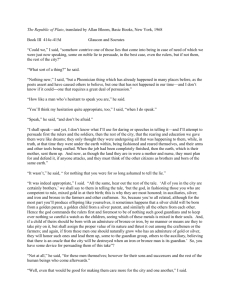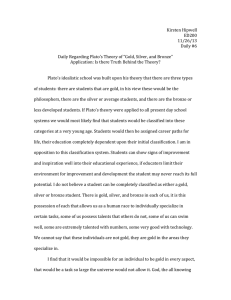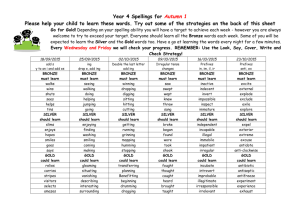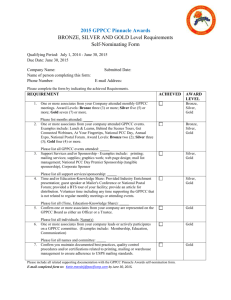Experiences in Applying for Silver Ann Muggeridge
advertisement
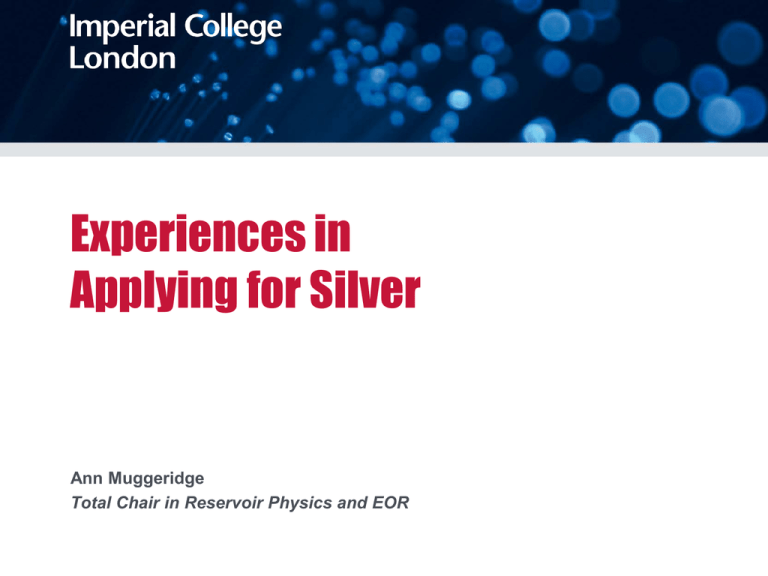
Experiences in Applying for Silver Ann Muggeridge Total Chair in Reservoir Physics and EOR Outline Time-line Setting up our self assessment team, Feedback from Bronze application Moving from bronze to silver Some pitfalls during the application/self assessment process, Feedback from Silver application Tips for success. Time-line November 2009 – HOD discusses a departmental application for a Silver SWAN award May 2010 – ESE submit application for Silver SWAN July 29th 2010 – ESE awarded a Bronze SWAN award – Feedback suggests applying for Silver in November 2011 October 2011 – Request data needed for Silver application and advised it will take >2months April 2012 – Submit Silver application July 2012 – Awarded Silver The Self Assessment Team Formed in January 2010 For 2012 application – Post doc Rep (male) – Administrator (female) – Prof from Dept of Physics SWAN/Juno committee (female) – Lecturer with young family (female) – Prof. Working part-time with young family (male) – Departmental Operations Administrator (female) – Research fellow (young, female, no family) – Prof/former HOD (male) + myself – Post doc Rep (female) – Administrator (female) – Rep from equality and diversity unit (female) – Senior lecturer with young family (female) – Prof. working part-time with young family (male) – Departmental Operations Administrator (female) – Research fellow (young, female, no family) – Prof/former HOD (male) – 2nd year PhD student (female) Feedback from Bronze Why compare ourselves with engineering faculty data? Why no monitoring of student data? – Not in action plan “low expectation and negative attitude towards female UGs” The proportion of women on our undergraduate degree courses has remained more or less static over the last three years at around 38%. This is a considerably larger proportion than on other undergraduate courses in the Engineering Faculty at Imperial (~22%) but ~2% less than the national average for geology courses (HESA) in 2008. Our undergraduate course is more numerical and scientific in content than typical geoscience courses (our undergraduates are studying towards one of five geoscience degrees: geology, geophysics, geology with geophysics, environmental geoscience or petroleum geoscience). Thus we would expect the proportion of women to be slightly lower than the national average for geology. In this context the proportion of women on our undergraduate courses is very reasonable. “some rather judgemental statements were made (such as beer no longer being served at student meetings to minimise ‘laddish’ behaviour which is off putting to female students)” “very little in place to support female students in progressing into postdoctoral and academic posts” “good mix of men and women on SAT at various career levels” but suggest including a uni. rep. for equality and diversity Insufficient monitoring of progress in terms of outcomes/measures of success in Action Plan Moving from Bronze to Silver Full set of data over 3 years – Suitable comparisons – Assistance at university level in obtaining data Athena Index exercise 2010 – Full review of departmental activity in key areas by SAT – Survey of staff – Time consuming, but valuable! Follow through Bronze Action Plan e.g. – – – – – Monitor gender ratios at all levels Improve induction procedure Better coaching of internal staff applying for promotions PRDP for everyone, every year Improve web site Learn from Bronze feedback Pitfalls Get access to data in good time – HR may need 3 months or more Engaged SAT – Everyone very busy Hard work to get everyone in department to do surveys – Focus groups Feedback from Silver “The panel wondered whether the statement that it was pleasing that the percentage of female undergraduates was in the middle of the range of national data displayed a lack of ambition.” “some actions could have been implemented already” – e.g. Female applicants to meet female postdocs “further investigation as to why a career in industry is more attractive would be beneficial” Need more women on female executive committee Action plan should be more SMART (Specific, Measurable, Accurate Realistic, Timely) – Better to embed ongoing actions as normal work processes Tips for Success Determine data needed and availability >3 months before application Assistance in obtaining, processing and displaying data Read other applications (unsuccessful too if possible) Engagement at all levels – University to department – PhD to HoD – Men and women » Emphasis on benefits to all Careful with wording of application – Limited space so be clear what points you want to make – Get colleagues and non-departmental feedback on document – SMART Action Plan
